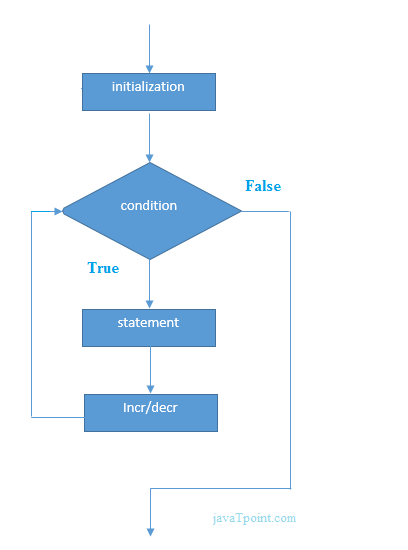TheDeveloperBlog.com
C-Sharp | Java | Python | Swift | GO | WPF | Ruby | Scala | F# | JavaScript | SQL | PHP | Angular | HTML
Loops in Java | Java For Loop
Loops in Java | Java for loop with java while loop, java for loop, java do-while loop, java for loop example, java for loop programs, labeled for loop, for each loop or advanced for loop, java infinite for loop example, java simple for loop, nested for loop with concepts and examples.
Loops in JavaThe Java for loop is used to iterate a part of the program several times. If the number of iteration is fixed, it is recommended to use for loop. There are three types of for loops in Java. 
Java Simple for Loop
A simple for loop is the same as C/C++. We can initialize the variable, check condition and increment/decrement value. It consists of four parts:
Syntax:
for(initialization; condition; increment/decrement){
//statement or code to be executed
}
Flowchart: 
Example: ForExample.java
//Java Program to demonstrate the example of for loop
//which prints table of 1
public class ForExample {
public static void main(String[] args) {
//Code of Java for loop
for(int i=1;i<=10;i++){
System.out.println(i);
}
}
}
Output: 1 2 3 4 5 6 7 8 9 10 Java Nested for Loop
If we have a for loop inside the another loop, it is known as nested for loop. The inner loop executes completely whenever outer loop executes. Example: NestedForExample.java
public class NestedForExample {
public static void main(String[] args) {
//loop of i
for(int i=1;i<=3;i++){
//loop of j
for(int j=1;j<=3;j++){
System.out.println(i+" "+j);
}//end of i
}//end of j
}
}
Output: 1 1 1 2 1 3 2 1 2 2 2 3 3 1 3 2 3 3 Pyramid Example 1: PyramidExample.java
public class PyramidExample {
public static void main(String[] args) {
for(int i=1;i<=5;i++){
for(int j=1;j<=i;j++){
System.out.print("* ");
}
System.out.println();//new line
}
}
}
Output: * * * * * * * * * * * * * * * Pyramid Example 2: PyramidExample2.java
public class PyramidExample2 {
public static void main(String[] args) {
int term=6;
for(int i=1;i<=term;i++){
for(int j=term;j>=i;j--){
System.out.print("* ");
}
System.out.println();//new line
}
}
}
Output: * * * * * * * * * * * * * * * * * * * * * Java for-each Loop
The for-each loop is used to traverse array or collection in Java. It is easier to use than simple for loop because we don't need to increment value and use subscript notation. It works on the basis of elements and not the index. It returns element one by one in the defined variable. Syntax:
for(data_type variable : array_name){
//code to be executed
}
Example: ForEachExample.java
//Java For-each loop example which prints the
//elements of the array
public class ForEachExample {
public static void main(String[] args) {
//Declaring an array
int arr[]={12,23,44,56,78};
//Printing array using for-each loop
for(int i:arr){
System.out.println(i);
}
}
}
Output: 12 23 44 56 78 Java Labeled For LoopWe can have a name of each Java for loop. To do so, we use label before the for loop. It is useful while using the nested for loop as we can break/continue specific for loop. Note: The break and continue keywords breaks or continues the innermost for loop respectively.Syntax:
labelname:
for(initialization; condition; increment/decrement){
//code to be executed
}
Example: LabeledForExample.java
//A Java program to demonstrate the use of labeled for loop
public class LabeledForExample {
public static void main(String[] args) {
//Using Label for outer and for loop
aa:
for(int i=1;i<=3;i++){
bb:
for(int j=1;j<=3;j++){
if(i==2&&j==2){
break aa;
}
System.out.println(i+" "+j);
}
}
}
}
Output: 1 1 1 2 1 3 2 1 If you use break bb;, it will break inner loop only which is the default behaviour of any loop. LabeledForExample2.java
public class LabeledForExample2 {
public static void main(String[] args) {
aa:
for(int i=1;i<=3;i++){
bb:
for(int j=1;j<=3;j++){
if(i==2&&j==2){
break bb;
}
System.out.println(i+" "+j);
}
}
}
}
Output: 1 1 1 2 1 3 2 1 3 1 3 2 3 3 Java Infinitive for LoopIf you use two semicolons ;; in the for loop, it will be infinitive for loop. Syntax:
for(;;){
//code to be executed
}
Example: ForExample.java
//Java program to demonstrate the use of infinite for loop
//which prints an statement
public class ForExample {
public static void main(String[] args) {
//Using no condition in for loop
for(;;){
System.out.println("infinitive loop");
}
}
}
Output: infinitive loop infinitive loop infinitive loop infinitive loop infinitive loop ctrl+c Now, you need to press ctrl+c to exit from the program. Java for Loop vs while Loop vs do-while Loop
Next TopicJava While Loop
|
Related Links:
- Java Continue Keyword
- Java Convert Char Array to String
- Java Combine Arrays
- Java Console Examples
- Java Web Services Tutorial
- Java Odd and Even Numbers: Modulo Division
- Java IO
- Java 9 Features
- Java 8 Features
- Java String
- Java Regex | Regular Expression
- Java Filename With Date Example (Format String)
- Java Applet Tutorial
- Java Files.Copy: Copy File
- Java filter Example: findFirst, IntStream
- Java Final and final static Constants
- Java Super: Parent Class
- Java Date and Time
- Java do while loop
- Java Break
- Java Continue
- Java Comments
- Java Splitter Examples: split, splitToList
- Java Math.sqrt Method: java.lang.Math.sqrt
- Java Reflection
- Java Convert String to int
- JDBC Tutorial | What is Java Database Connectivity(JDBC)
- Java main() method
- Java HashMap Examples
- Java HashSet Examples
- Java Arrays.binarySearch
- Java Integer.bitCount and toBinaryString
- Java Overload Method Example
- Java First Words in String
- Java Convert ArrayList to String
- Java Convert boolean to int (Ternary Method)
- Java regionMatches Example and Performance
- Java ArrayDeque Examples
- Java ArrayList add and addAll (Insert Elements)
- Java ArrayList Clear
- Java ArrayList int, Integer Example
- Java ArrayList Examples
- Java Boolean Examples
- Java break Statement
- Java Newline Examples: System.lineSeparator
- Java Stream: Arrays.stream and ArrayList stream
- Java charAt Examples (String For Loop)
- Java Programs | Java Programming Examples
- Java OOPs Concepts
- Java Naming Conventions
- Java Constructor
- Java Class Example
- Java indexOf Examples
- Java Collections.addAll: Add Array to ArrayList
- Java Compound Interest
- Java Int Array
- Java Interface Examples
- Java 2D Array Examples
- Java Remove HTML Tags
- Java Stack Examples: java.util.Stack
- Java Enum Examples
- Java EnumMap Examples
- Java StackOverflowError
- Java startsWith and endsWith Methods
- Java Initialize ArrayList
- Java Object Array Examples: For, Cast and getClass
- Java Objects, Objects.requireNonNull Example
- Java Optional Examples
- Java Static Initializer
- Java static Keyword
- Java Package: Import Keyword Example
- Java Do While Loop Examples
- Java Double Numbers: Double.BYTES and Double.SIZE
- Java Truncate Number: Cast Double to Int
- Java Padding: Pad Left and Right of Strings
- Java Anagram Example: HashMap and ArrayList
- Java Math.abs: Absolute Value
- Java Extends: Class Inheritance
- Java String Class
- Java String Switch Example: Switch Versus HashMap
- Java StringBuffer: append, Performance
- Java Array Examples
- Java Remove Duplicates From ArrayList
- Java if, else if, else Statements
- Java Math.ceil Method
- Java This Keyword
- Java PriorityQueue Example (add, peek and poll)
- Java Process.start EXE: ProcessBuilder Examples
- Java Palindrome Method
- Java parseInt: Convert String to Int
- Java toCharArray: Convert String to Array
- Java Caesar Cipher
- Java Array Length: Get Size of Array
- Java String Array Examples
- Java String compareTo, compareToIgnoreCase
- Java String Concat: Append and Combine Strings
- Java Cast and Convert Types
- Java Math.floor Method, floorDiv and floorMod
- Java Math Class: java.lang.Math
- Java While Loop Examples
- Java Reverse String
- Java Download Web Pages: URL and openStream
- Java Math.pow Method
- Java Math.round Method
- Java Right String Part
- Java MongoDB Example
- Java Substring Examples, subSequence
- Java Prime Number Method
- Java Sum Methods: IntStream and reduce
- Java switch Examples
- Java Convert HashMap to ArrayList
- Java Remove Duplicate Chars
- Java Constructor: Overloaded, Default, This Constructors
- Java String isEmpty Method (Null, Empty Strings)
- Java Regex Examples (Pattern.matches)
- Java ROT13 Method
- Java Random Number Examples
- Java Recursion Example: Count Change
- Java reflect: getDeclaredMethod, invoke
- Java Count Letter Frequencies
- Java ImmutableList Examples
- Java String equals, equalsIgnoreCase and contentEquals
- Java valueOf and copyValueOf String Examples
- Java Vector Examples
- Java Word Count Methods: Split and For Loop
- Java Tutorial | Learn Java Programming
- Java toLowerCase, toUpperCase Examples
- Java Ternary Operator
- Java Tree: HashMap and Strings Example
- Java TreeMap Examples
- Java while loop
- Java Convert String to Byte Array
- Java Join Strings: String.join Method
- Java Modulo Operator Examples
- Java Integer.MAX VALUE, MIN and SIZE
- Java Lambda Expressions
- Java lastIndexOf Examples
- Java Multiple Return Values
- Java String.format Examples: Numbers and Strings
- Java Joiner Examples: join
- Java Keywords
- Java Replace Strings: replaceFirst and replaceAll
- Java return Examples
- Java Multithreading Interview Questions (2021)
- Java Collections Interview Questions (2021)
- Java Shuffle Arrays (Fisher Yates)
- Top 30 Java Design Patterns Interview Questions (2021)
- Java ListMultimap Examples
- Java String Occurrence Method: While Loop Method
- Java StringBuilder capacity
- Java Math.max and Math.min
- Java Factory Design Pattern
- Java StringBuilder Examples
- Java Mail Tutorial
- Java Swing Tutorial
- Java AWT Tutorial
- Java Fibonacci Sequence Examples
- Java StringTokenizer Example
- Java Method Examples: Instance and Static
- Java String Between, Before, After
- Java BitSet Examples
- Java System.gc, Runtime.getRuntime and freeMemory
- Java Character Examples
- Java Char Lookup Table
- Java BufferedWriter Examples: Write Strings to Text File
- Java Abstract Class
- Java Hashtable
- Java Math class with Methods
- Java Whitespace Methods
- Java Data Types
- Java Trim String Examples (Trim Start, End)
- Java Exceptions: try, catch and finally
- Java vs C#
- Java Float Numbers
- Java Truncate String
- Java Variables
- Java For Loop Examples
- Java Uppercase First Letter
- Java Inner Class
- Java Networking
- Java Keywords
- Java If else
- Java Switch
- Loops in Java | Java For Loop
- Java File: BufferedReader and FileReader
- Java Random Lowercase Letter
- Java Calendar Examples: Date and DateFormat
- Java Case Keyword
- Java Char Array
- Java ASCII Table
- Java IntStream.Range Example (Get Range of Numbers)
- Java length Example: Get Character Count
- Java Line Count for File
- Java Sort Examples: Arrays.sort, Comparable
- Java LinkedHashMap Example
- Java Split Examples


